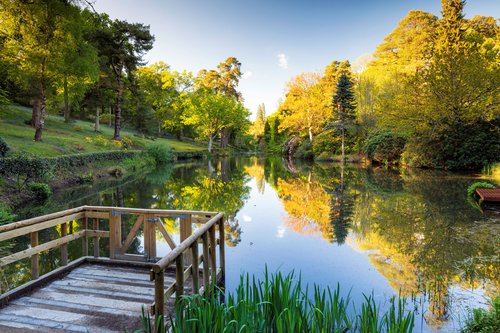Blooming beauty
Mike Sims finds out more about the meticulous work to restore a 240-acre estate in one of the UK’s largest garden restoration projects
Entrepreneur Penny Streeter saw a ‘for sale’ sign when driving past a field in West Sussex, and curiosity got the better of her. She parked up and clambered through a jungle of weeds to discover a derelict and abandoned property, Leonardslee House.
Penny promptly bought the historic 240-acre estate, which had been closed for several years, and set about restoring it to its former glory – as originally conceived by the creator of the gardens, Sir Edmund Loder, one of the great Victorian plant collectors.
The Streeters knew it could be renovated and nurtured to become the national treasure that it is today, and five years later, its Grade I listed gardens are now attracting international visitors and attention. The multi-million-pound transformation has been one of the largest UK garden restoration projects of the past 30 years, and one that has elicited a strong reaction from the wider community.
Son Adam, the estate’s general manager, says: “We have had a fantastic response from the public, our supporters, with some 150,000 visitors annually – and this number is steadily increasing. We took the decision to allow dogs on leads, and that has worked well. People have responded responsibly.”
Adam Streeter is general manager of Leonardslee Lakes and Gardens. He has managed all aspects of the restoration and running of the estate today, including the Michelin-starred restaurant Interlude, new accommodation and year-round events programme. Penny Streeter is a serial entrepreneur who runs a successful healthcare staffi ng business and hospitality estates in the UK and South Africa, which include vineyards. At the start of her career, she was living in a homeless refuge with a young family; in 2006 she was awarded an OBE for services to enterprise.

Diverse flora and fauna
Leonardslee Lakes and Gardens, near Horsham, is known for its year-round floral displays. It is home to a colony of wallabies who wander the estate, as well as a deer park and rare fauna and flora.
The grounds contain an acclaimed Pulham rock garden that was built in 1890, a sculpture park created with South African artist Anton Smit, a dolls’ house exhibition that depicts the Edwardian era estate and neighbouring villages at 1:12 scale, a full events and festivals programme, a restaurant that won a Michelin star within a year of opening, and recently-opened luxury accommodation. There is also England’s first Pinotage vineyard, with the first release of wine set for 2023.
It is a far cry from the estate that the Streeters took on in 2017. “It was an 18-month project which involved major works in clearing heavily overgrown woodlands,” continues Adam. “The 10km of pathways were completely buried and subsided, so they had to be rebuilt by hand for both health and safety purposes and also the practical issue of moving around the estate, which is largely set in a steep valley.
“There are some 10,000 trees, each of which had to be surveyed and registered, and the team had to cut any infirm trees or limbs that might fall.
“There were also major works in restoring the derelict mansion house and installing new kitchens, rooms for afternoon tea and dining facilities to the highest standards. The reward was in winning a coveted Michelin star in less than a year from opening – a near-unique achievement under executive chef Jean Delport, whom we brought over from his home in South Africa.
“We also had to rebuild or repair all the glasshouses and create a new reception area from one of the major structures, as well as creating an adjoining all-weather car park with spaces for 850 vehicles.
Progress in developing the reception was delayed for many months when a great crested newt – a protected species – was discovered.”
More than 100 people were employed during the peak phase, with the team “enthused by working on such a very special project, as the beauty of the estate and its flora and fauna were revealed day by day,” adds Adam. They planted hundreds of thousands of bluebells, daffodils, snowdrops and others to ensure the gardens offer year-round appeal – something that is critical to the future viability of the estate.
Lessons learnt

While the sheer enormity of the work was the biggest challenge, it allowed the Streeters to appreciate the versatility and variety of the property, and several lessons were learnt – including: “Don’t underestimate the scale of a project like this.” Asked what advice they have for other CLA members who might be looking to engage in a restoration project, Adam says: “Everything takes up to twice as long as you would estimate. You investigate one problem, only to discover several others."
However, it is incredibly rewarding personally, especially knowing we are helping to save so much threatened wildlife
"We have emperor dragonflies and damselflies, white admiral and purple hairstreak butterflies, and migratory and native birds – kites, great tits, tree creepers, nuthatches, woodpeckers and nightingales.”
The work isn’t complete yet, though; there are plans to further upgrade the visitor centre and greenhouses, as well as the farm shop, wine tasting rooms and café. The team is also drawing up a detailed garden management plan to introduce new plants and wildlife. “It is a never-ending programme of conservation and renewal, including of our most famous attractions in perhaps the greatest spring gardens in England – the rhododendrons, azaleas, camellias, magnolias and bluebells,” Adam concludes.